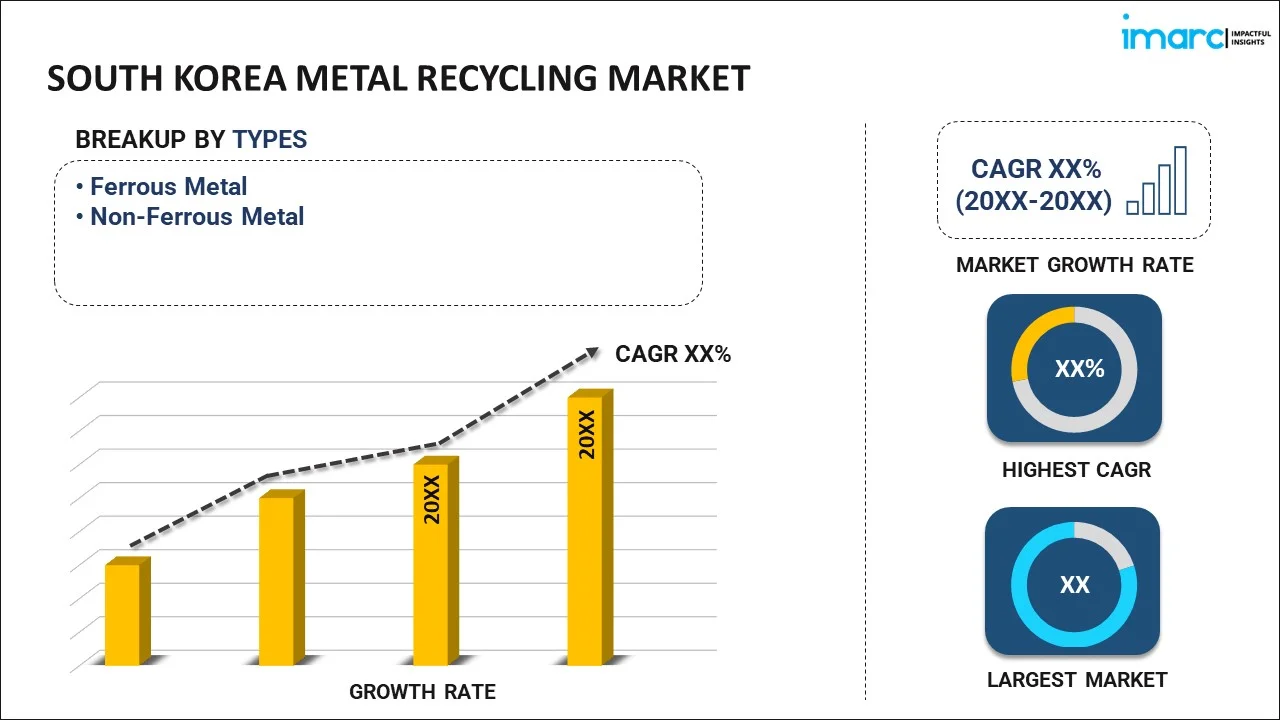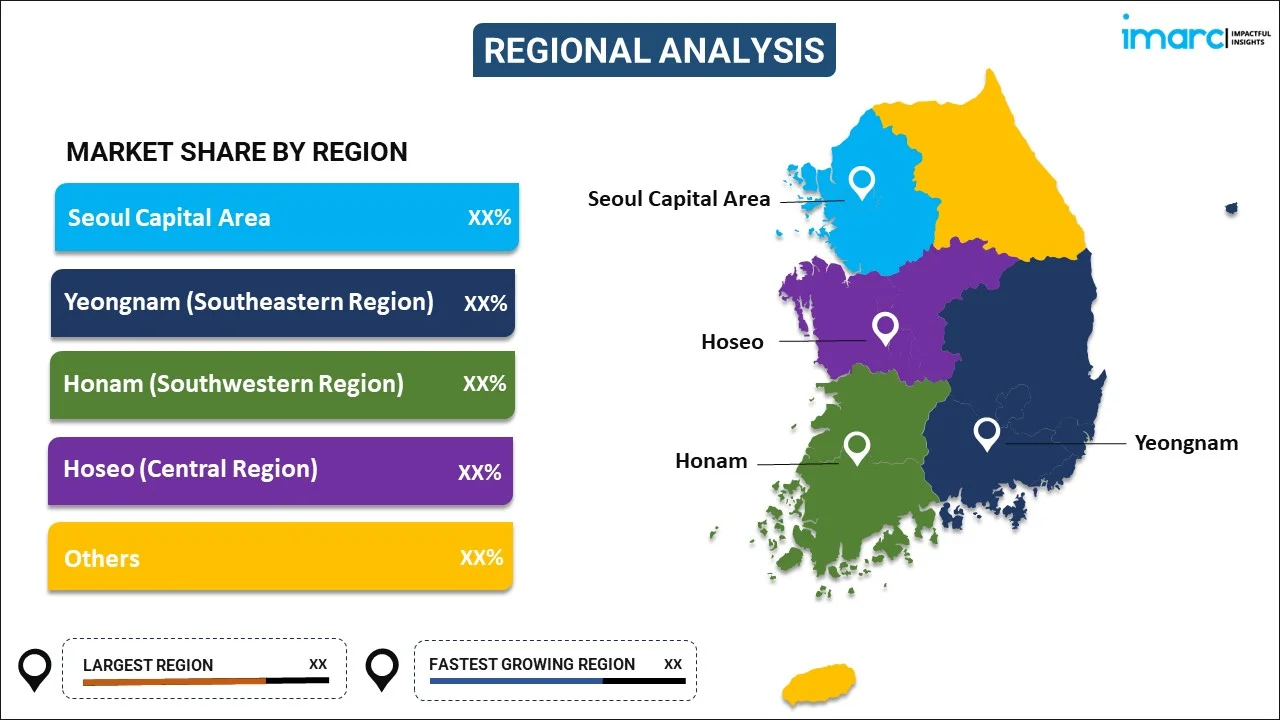
South Korea Metal Recycling Market Report by Type (Ferrous Metal, Non-Ferrous Metal), End Use Industry (Building and Construction, Packaging, Automotive, Industrial Machinery, Electronics and Electrical Equipment, Shipbuilding, and Others), and Region 2025-2033
Market Overview:
South Korea metal recycling market size reached USD 4.8 Billion in 2024. Looking forward, IMARC Group expects the market to reach USD 6.6 Billion by 2033, exhibiting a growth rate (CAGR) of 3.2% during 2025-2033. The increasing demand for metals in various industries, including construction, automotive, electronics, and packaging, which enhances the need for a stable and sustainable metal supply, is driving the market.
|
Report Attribute
|
Key Statistics
|
|---|---|
|
Base Year
|
2024 |
|
Forecast Years
|
2025-2033 |
|
Historical Years
|
2019-2024
|
| Market Size in 2024 | USD 4.8 Billion |
| Market Forecast in 2033 | USD 6.6 Billion |
| Market Growth Rate (2025-2033) | 3.2% |
Metal recycling is the process of collecting, processing, and reusing metals to create new products. This sustainable practice helps conserve natural resources, reduce energy consumption, and minimize environmental impact. In the early phase, metal recycling was often a manual and localized effort driven by economic considerations and resource scarcity. Scrap metal, including iron, copper, and aluminum, was salvaged from various sources, such as old machinery, buildings, and discarded goods. As industrialization progressed, organized metal recycling became more prevalent. Today, advanced technologies and recycling infrastructure enable efficient metal recovery. The recycling industry plays a crucial role in mitigating the environmental impact of metal extraction and production, contributing to a circular economy where materials are reused, reducing the need for raw material extraction, and decreasing waste.
South Korea Metal Recycling Market Trends:
The metal recycling market in South Korea is experiencing robust growth, primarily propelled by increasing environmental consciousness and stringent regulations governing waste disposal. Governments are actively promoting sustainable practices, fostering a favorable environment for the metal recycling industry. Moreover, the escalating demand for raw materials, coupled with the finite nature of natural resources, is steering industries toward recycling as a viable alternative. This imperative shift is driven by a dual commitment to resource conservation and reducing carbon footprints. In addition to regulatory support, technological advancements are playing a pivotal role in enhancing the efficiency of metal recycling processes. Innovations in sorting and separation technologies enable the extraction of valuable metals from complex waste streams, thereby contributing to the market's expansion. Furthermore, the rising awareness among industries about the economic benefits associated with recycling, such as cost savings and reduced energy consumption, is stimulating greater participation in metal recycling initiatives. The circular economy concept has gained prominence, fostering a closed-loop system where recycled metals are reintegrated into the production cycle. This circular approach not only conserves resources but also diminishes the environmental impact of metal extraction. In conclusion, the metal recycling market in South Korea is being driven by a confluence of regulatory support, technological advancements, economic incentives, and a growing commitment to sustainable practices.
South Korea Metal Recycling Market Segmentation:
IMARC Group provides an analysis of the key trends in each segment of the market, along with forecasts at the country level for 2025-2033. Our report has categorized the market based on type and end use industry.
Type Insights:

- Ferrous Metal
- Non-Ferrous Metal
The report has provided a detailed breakup and analysis of the market based on the type. This includes ferrous metal and non-ferrous metal.
End Use Industry Insights:
- Building and Construction
- Packaging
- Automotive
- Industrial Machinery
- Electronics and Electrical Equipment
- Shipbuilding
- Others
A detailed breakup and analysis of the market based on the end use industry have also been provided in the report. This includes building and construction, packaging, automotive, industrial machinery, electronics and electrical equipment, shipbuilding, and others.
Regional Insights:

- Seoul Capital Area
- Yeongnam (Southeastern Region)
- Honam (Southwestern Region)
- Hoseo (Central Region)
- Others
The report has also provided a comprehensive analysis of all the major regional markets, which include Seoul Capital Area, Yeongnam (Southeastern Region), Honam (Southwestern Region), Hoseo (Central Region), and Others.
Competitive Landscape:
The market research report has also provided a comprehensive analysis of the competitive landscape in the market. Competitive analysis such as market structure, key player positioning, top winning strategies, competitive dashboard, and company evaluation quadrant has been covered in the report. Also, detailed profiles of all major companies have been provided.
South Korea Metal Recycling Market Report Coverage:
| Report Features | Details |
|---|---|
| Base Year of the Analysis | 2024 |
| Historical Period | 2019-2024 |
| Forecast Period | 2025-2033 |
| Units | Billion USD |
| Scope of the Report | Exploration of Historical and Forecast Trends, Industry Catalysts and Challenges, Segment-Wise Historical and Predictive Market Assessment:
|
| Types Covered | Ferrous Metal, Non-Ferrous Metal |
| End Use Industries Covered | Building and Construction, Packaging, Automotive, Industrial Machinery, Electronics and Electrical Equipment, Shipbuilding, Others |
| Regions Covered | Seoul Capital Area, Yeongnam (Southeastern Region), Honam (Southwestern Region), Hoseo (Central Region), Others |
| Customization Scope | 10% Free Customization |
| Post-Sale Analyst Support | 10-12 Weeks |
| Delivery Format | PDF and Excel through Email (We can also provide the editable version of the report in PPT/Word format on special request) |
Key Questions Answered in This Report:
- How has the South Korea metal recycling market performed so far and how will it perform in the coming years?
- What has been the impact of COVID-19 on the South Korea metal recycling market?
- What is the breakup of the South Korea metal recycling market on the basis of type?
- What is the breakup of the South Korea metal recycling market on the basis of end use industry?
- What are the various stages in the value chain of the South Korea metal recycling market?
- What are the key driving factors and challenges in the South Korea metal recycling?
- What is the structure of the South Korea metal recycling market and who are the key players?
- What is the degree of competition in the South Korea metal recycling market?
Key Benefits for Stakeholders:
- IMARC’s industry report offers a comprehensive quantitative analysis of various market segments, historical and current market trends, market forecasts, and dynamics of the South Korea metal recycling market from 2019-2033.
- The research report provides the latest information on the market drivers, challenges, and opportunities in the South Korea metal recycling market.
- Porter's five forces analysis assist stakeholders in assessing the impact of new entrants, competitive rivalry, supplier power, buyer power, and the threat of substitution. It helps stakeholders to analyze the level of competition within the South Korea metal recycling industry and its attractiveness.
- Competitive landscape allows stakeholders to understand their competitive environment and provides an insight into the current positions of key players in the market.
Need more help?
- Speak to our experienced analysts for insights on the current market scenarios.
- Include additional segments and countries to customize the report as per your requirement.
- Gain an unparalleled competitive advantage in your domain by understanding how to utilize the report and positively impacting your operations and revenue.
- For further assistance, please connect with our analysts.
 Inquire Before Buying
Inquire Before Buying
 Speak to an Analyst
Speak to an Analyst
 Request Brochure
Request Brochure
 Request Customization
Request Customization




.webp)




.webp)












